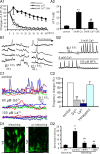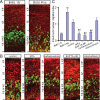Gap junctions/hemichannels modulate interkinetic nuclear migration in the forebrain precursors
- PMID: 20335455
- PMCID: PMC2861434
- DOI: 10.1523/JNEUROSCI.4187-09.2010
Gap junctions/hemichannels modulate interkinetic nuclear migration in the forebrain precursors
Abstract
During mitotic division in the telencephalic proliferative ventricular zone (VZ), the nuclei of the neural precursors move basally away from the ventricular surface for DNA synthesis, and apically return to the surface for mitotic division; a process known as interkinetic migration or "to-and-fro" nuclear translocation. The cell, which remains attached to the ventricular surface, either continues cycling, or exits the cycle and migrates to the subventricular zone or the developing cortical plate. Although gap junctions/hemichannels are known to modulate DNA synthesis via Ca(2+) waves, the role of Ca(+) oscillations and the mechanism of nuclear translocation in the VZ precursors are unclear. Here, we provide evidence that, during apical nuclear migration, VZ precursors display dynamic spontaneous Ca(2+) transients, which depend on functional gap junctions/hemichannels via ATP release and Ca(2+)-mobilizing messenger diffusion. Furthermore, we found that blocking gap junctions/hemichannels or short hairpin RNA-mediated knockdown of Cx43 (connexin 43) retards the apically directed interkinetic nuclear migration accompanied with changes in the nuclear length/width ratio. In addition, we demonstrated that blocking functional gap junctions/hemichannels induces phosphorylation of small GTPase cdc42 in the VZ precursors. The basal phase of interkinetic migration is much slower and appears to be mediated passively by mechanical forces after cell division. Our findings indicate that functional interference with gap junctions/hemichannels during embryonic development may lead to abnormal corticogenesis and dysfunction of the cerebral cortex in adult organisms.
Figures









Similar articles
-
Gap junctions modulate interkinetic nuclear movement in retinal progenitor cells.J Neurosci. 2005 Nov 16;25(46):10803-14. doi: 10.1523/JNEUROSCI.2312-05.2005. J Neurosci. 2005. PMID: 16291954 Free PMC article.
-
Astroglial connexin43 hemichannels tune basal excitatory synaptic transmission.J Neurosci. 2014 Aug 20;34(34):11228-32. doi: 10.1523/JNEUROSCI.0015-14.2014. J Neurosci. 2014. PMID: 25143604 Free PMC article.
-
Roles of astrocytic connexin-43, hemichannels, and gap junctions in oxygen-glucose deprivation/reperfusion injury induced neuroinflammation and the possible regulatory mechanisms of salvianolic acid B and carbenoxolone.J Neuroinflammation. 2018 Mar 27;15(1):97. doi: 10.1186/s12974-018-1127-3. J Neuroinflammation. 2018. PMID: 29587860 Free PMC article.
-
Connexin and pannexin hemichannels in inflammatory responses of glia and neurons.Brain Res. 2012 Dec 3;1487:3-15. doi: 10.1016/j.brainres.2012.08.042. Epub 2012 Sep 10. Brain Res. 2012. PMID: 22975435 Free PMC article. Review.
-
Peptides and peptide-derived molecules targeting the intracellular domains of Cx43: gap junctions versus hemichannels.Neuropharmacology. 2013 Dec;75:491-505. doi: 10.1016/j.neuropharm.2013.04.050. Epub 2013 May 7. Neuropharmacology. 2013. PMID: 23664811 Review.
Cited by
-
Physiological and molecular characterization of connexin hemichannels in zebrafish retinal horizontal cells.J Neurophysiol. 2012 May;107(10):2624-32. doi: 10.1152/jn.01126.2011. Epub 2012 Feb 22. J Neurophysiol. 2012. PMID: 22357795 Free PMC article.
-
Connexins and Pannexins: New Insights into Microglial Functions and Dysfunctions.Front Mol Neurosci. 2016 Sep 22;9:86. doi: 10.3389/fnmol.2016.00086. eCollection 2016. Front Mol Neurosci. 2016. PMID: 27713688 Free PMC article. Review.
-
Molecules and mechanisms that regulate multipolar migration in the intermediate zone.Front Cell Neurosci. 2014 Nov 14;8:386. doi: 10.3389/fncel.2014.00386. eCollection 2014. Front Cell Neurosci. 2014. PMID: 25452716 Free PMC article. Review.
-
Gap Junctions and Wnt Signaling in the Mammary Gland: a Cross-Talk?J Mammary Gland Biol Neoplasia. 2019 Mar;24(1):17-38. doi: 10.1007/s10911-018-9411-5. Epub 2018 Sep 7. J Mammary Gland Biol Neoplasia. 2019. PMID: 30194659 Review.
-
Expression of ecto-ATPase NTPDase2 in human dental pulp.J Dent Res. 2012 Mar;91(3):261-7. doi: 10.1177/0022034511431582. Epub 2011 Dec 14. J Dent Res. 2012. PMID: 22173326 Free PMC article.
References
-
- Alexandre H, Van Cauwenberge A, Mulnard J. Involvement of microtubules and microfilaments in the control of the nuclear movement during maturation of mouse oocyte. Dev Biol. 1989;136:311–320. - PubMed
-
- Algan O, Rakic P. Radiation-induced, lamina-specific deletion of neurons in the primate visual cortex. J Comp Neurol. 1997;381:335–352. - PubMed
-
- Anselmi F, Hernandez VH, Crispino G, Seydel A, Ortolano S, Roper SD, Kessaris N, Richardson W, Rickheit G, Filippov MA, Monyer H, Mammano F. ATP release through connexin hemichannels and gap junction transfer of second messengers propagate Ca2+ signals across the inner ear. Proc Natl Acad Sci U S A. 2008;105:18770–18775. - PMC - PubMed
-
- Azzam EI, de Toledo SM, Little JB. Expression of CONNEXIN43 is highly sensitive to ionizing radiation and other environmental stresses. Cancer Res. 2003;63:7128–7135. - PubMed
Publication types
MeSH terms
Substances
Grants and funding
LinkOut - more resources
Full Text Sources
Other Literature Sources
Medical
Miscellaneous
